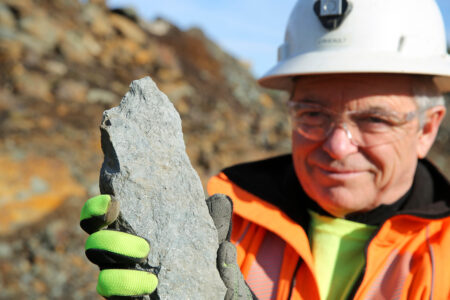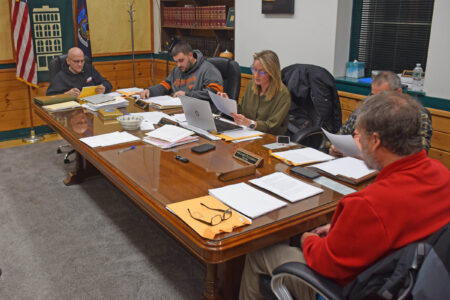Preliminary report on Lake Placid airplane crash released

Lake Placid volunteer firefighters at the site of the fatal airplane crash in Lake Placid on Oct. 1. (Enterprise photo — Aaron Marbone)
LAKE PLACID — The National Transportation Safety Board released its preliminary investigation report about the fatal Oct. 1 airplane crash in Lake Placid on Friday.
The report corrects previous information the NTSB released about the crash, which investigators believe was caused by an engine failure, including the direction of the plane’s final maneuver. The NTSB has retained the wreckage for further investigation. A final factual report — which will include further analysis and a probable cause for the crash — will be available in about 18 months, according to NTSB lead investigator Todd Gunther.
At an Oct. 3 press conference, Gunther said that the crash was likely caused by a loss of engine power. At the time, the NTSB was just beginning its investigation.
The report released Friday confirms that the Cessna 177RG owned and operated by Lake Placid Airways, formerly known as Adirondack Flying Service, was supposed to be photographed while airborne for a magazine article that day. The photographer’s plane, a Beech A36, took off with no issues. The Cessna took off about 700 feet behind the Beech.
The Cessna was being flown by new Lake Placid Airways owner and former NFL tight end Russ Francis. Passenger Richard McSpadden, who was the Aircraft Owners and Pilots Association’s senior vice president, planned to take over the controls and fly the plane during the airborne photoshoot.
According to the report, witnesses heard the Cessna’s engine running as it taxied down the runway. The engine then shut off and restarted about 10 seconds later. During the takeoff roll — which is the part of takeoff procedure when the plane is accelerated to a speed sufficient to become airborne — a witness reportedly observed the engine sounding like the propeller was set for “climb” and not takeoff. Climb is the portion of a flight in which the aircraft is reaching cruising altitude; it immediately follows takeoff. The same witness then heard the engine surge.
The witness also said that the plane did not sound as if it was running at full power as it began to climb. Once the Cessna reached about 300 to 400 feet in altitude, it reportedly made a “gentle left turn” in order to join formation with the Beech. When the Cessna got within 1,000 feet of the Beech, at 4:08 p.m., it “suddenly made a hard right turn back toward the departure airport.” This is a change from the NTSB’s incident report, which described the Cessna’s maneuver as a “hard roll to the left.”
As the plane made this maneuver, McSpadden radioed that the plane had a problem and they would return to the airport.
The Cessna did not reach the runway and instead hit an embankment below it, about 15 feet below the plateau. The plane’s nose and right wing made impact first. The Cessna then slid 30 feet down the embankment, where it came to rest. The initial area of impact was about 440 feet from the runway.
An eye witness, Ryan Branchaud, told the Enterprise on Oct. 3 that he saw the crash while sitting on the front porch of his home nearby. He immediately jumped in his car and drove over to the crash site, along with a neighbor, Kevin Reynolds, and Lake Placid School fifth grade science teacher Jon Fremante. They attempted to open the door to the aircraft, diverted leaking fuel away from Francis and McSpadden and tried to keep both of them conscious while waiting for first responders to arrive. Both Francis and McSpadden died as a result of their injuries.
The NTSB report said that the Lake Placid Airport’s runway was in “good condition.” The Cessna was manufactured in 1976 and was most recently inspected on April 7. At the time of the crash, the engine had accumulated 36.7 hours of operation since a “major overhaul.”
According to FAA records, Francis held a commercial pilot certificate, with ratings for airplane single-engine land, multiengine land and instrument airplane. He reported that he had accrued approximately 9,000 total flight hours as of Jan. 6.
Lake Placid Airways operates a flight service at the Lake Placid Airport. It was transferred to new ownership this year after nearly 50 years under Steve Short, who took over the airport after his father, the previous owner, suffered an aneurysm in 1974. Al Furnia started the Adirondack Flying Service; Steve Short’s father took over from Furnia after Furnia got cancer.
Francis, 70, was the new owner of Lake Placid Airways alongside Rives Potts, 74.
Francis was drafted as both a pitcher for the Kansas City Royals in the 1974 Major League Baseball draft and as a third-string tight end for the New England Patriots in 1975. He went the football route. He was selected for the Pro Bowl during three consecutive seasons — 1977, 1978 and 1979 — and sat out the 1981 NFL season before playing six years with the San Francisco 49ers. It was with the 49ers that he would earn a Super Bowl ring in 1985. He retired in 1989 with 393 receptions and 5,262 receiving yards over his career.
When he was designated All-Pro, sports broadcaster and Francis’ friend Howard Cosell said he was “All-World.”
McSpadden, 63, was a pilot with an “infectious passion” for flight and aircraft safety. McSpadden had been with the AOPA since 2017, first as the executive director of AOPA’s Air Safety Institute and since 2020 as the senior VP. He wrote many reports on crashes, which served as guides to others on how to avoid tragedy. His death in an airplane crash struck to the heart of the aviation enthusiasts who followed his work.
There have been at least 17 airplane crashes in Lake Placid since 1962, the most recent in 2014, according to NTSB records and past articles in the Enterprise.


